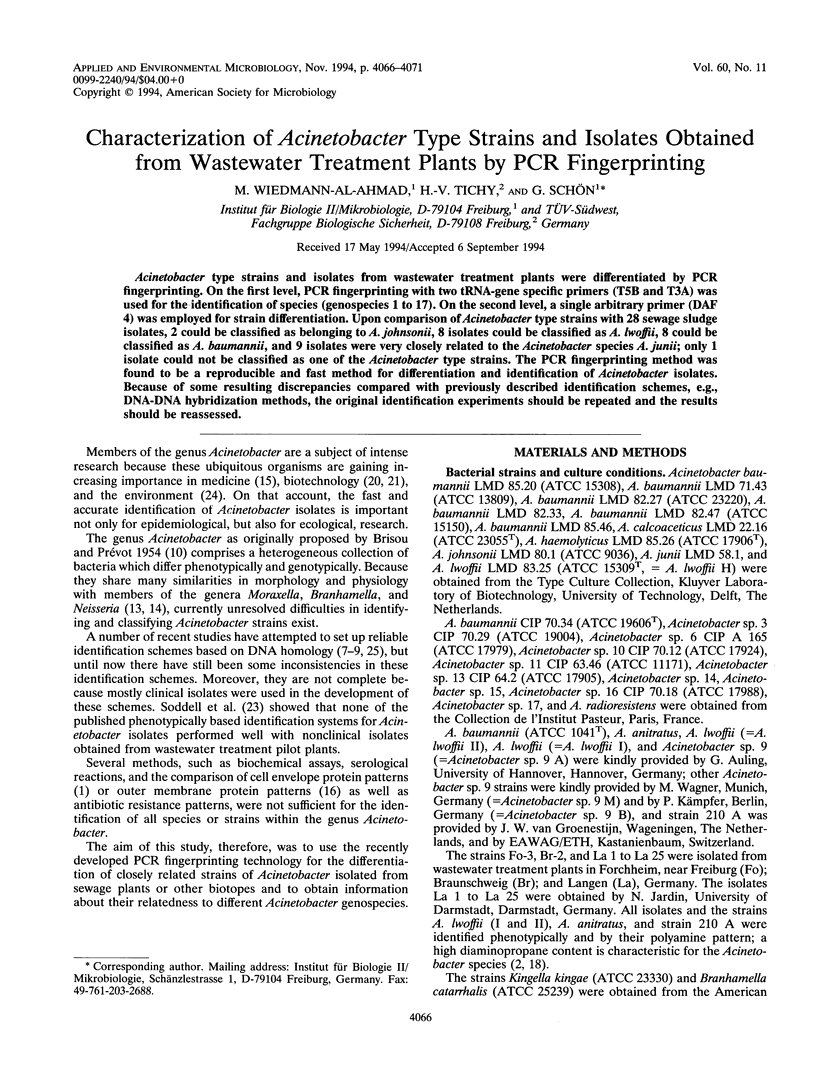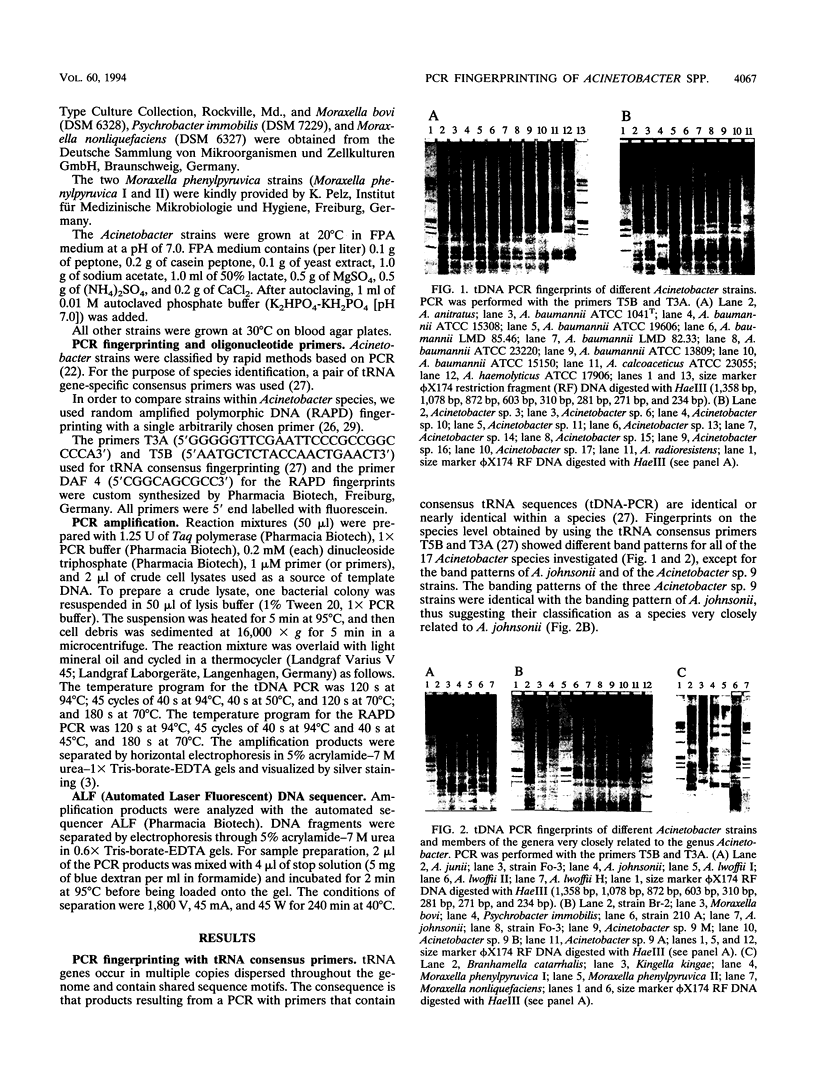Abstract
Acinetobacter type strains and isolates from wastewater treatment plants were differentiated by PCR fingerprinting. On the first level, PCR fingerprinting with two tRNA-gene specific primers (T5B and T3A) was used for the identification of species (genospecies 1 to 17). On the second level, a single arbitrary primer (DAF 4) was employed for strain differentiation. Upon comparison of Acinetobacter type strains with 28 sewage sludge isolates, 2 could be classified as belonging to A. johnsonii, 8 isolates could be classified as A. lwoffii, 8 could be classified as A. baumannii, and 9 isolates were very closely related to the Acinetobacter species A. junii; only 1 isolate could not be classified as one of the Acinetobacter type strains. The PCR fingerprinting method was found to be a reproducible and fast method for differentiation and identification of Acinetobacter isolates. Because of some resulting discrepancies compared with previously described identification schemes, e.g., DNA-DNA hybridization methods, the original identification experiments should be repeated and the results should be reassessed.
Full text
PDF





Images in this article
Selected References
These references are in PubMed. This may not be the complete list of references from this article.
- Alexander M., Ismail F., Jackman P. J., Noble W. C. Fingerprinting Acinetobacter strains from clinical sources by numerical analysis of electrophoretic protein patterns. J Med Microbiol. 1984 Aug;18(1):55–64. doi: 10.1099/00222615-18-1-55. [DOI] [PubMed] [Google Scholar]
- Auling G., Pilz F., Busse H. J., Karrasch S., Streichan M., Schön G. Analysis of the polyphosphate-accumulating microflora in phosphorus-eliminating, anaerobic-aerobic activated sludge systems by using diaminopropane as a biomarker for rapid estimation of Acinetobacter spp. Appl Environ Microbiol. 1991 Dec;57(12):3585–3592. doi: 10.1128/aem.57.12.3585-3592.1991. [DOI] [PMC free article] [PubMed] [Google Scholar]
- BRISOU J., PREVOT A. R. Etudes de systématique bactérienne. X. Révision des especes réunies dans le genre Achromobacter. Ann Inst Pasteur (Paris) 1954 Jun;86(6):722–728. [PubMed] [Google Scholar]
- Bassam B. J., Caetano-Anollés G., Gresshoff P. M. Fast and sensitive silver staining of DNA in polyacrylamide gels. Anal Biochem. 1991 Jul;196(1):80–83. doi: 10.1016/0003-2697(91)90120-i. [DOI] [PubMed] [Google Scholar]
- Bouvet P. J., Grimont P. A. Identification and biotyping of clinical isolates of Acinetobacter. Ann Inst Pasteur Microbiol. 1987 Sep-Oct;138(5):569–578. doi: 10.1016/0769-2609(87)90042-1. [DOI] [PubMed] [Google Scholar]
- Bouvet P. J., Jeanjean S. Delineation of new proteolytic genomic species in the genus Acinetobacter. Res Microbiol. 1989 May-Jun;140(4-5):291–299. doi: 10.1016/0923-2508(89)90021-1. [DOI] [PubMed] [Google Scholar]
- Gräser Y., Klare I., Halle E., Gantenberg R., Buchholz P., Jacobi H. D., Presber W., Schönian G. Epidemiological study of an Acinetobacter baumannii outbreak by using polymerase chain reaction fingerprinting. J Clin Microbiol. 1993 Sep;31(9):2417–2420. doi: 10.1128/jcm.31.9.2417-2420.1993. [DOI] [PMC free article] [PubMed] [Google Scholar]
- Henriksen S. D. Moraxella, Acinetobacter, and the Mimeae. Bacteriol Rev. 1973 Dec;37(4):522–561. doi: 10.1128/br.37.4.522-561.1973. [DOI] [PMC free article] [PubMed] [Google Scholar]
- Henriksen S. D. Moraxella, neisseria, branhamella, and acinetobacter. Annu Rev Microbiol. 1976;30:63–83. doi: 10.1146/annurev.mi.30.100176.000431. [DOI] [PubMed] [Google Scholar]
- Hoffmann S., Mabeck C. E., Vejlsgaard R. Bacteriuria caused by Acinetobacter calcoaceticus biovars in a normal population and in general practice. J Clin Microbiol. 1982 Sep;16(3):443–451. doi: 10.1128/jcm.16.3.443-451.1982. [DOI] [PMC free article] [PubMed] [Google Scholar]
- Martin G. B., Williams J. G., Tanksley S. D. Rapid identification of markers linked to a Pseudomonas resistance gene in tomato by using random primers and near-isogenic lines. Proc Natl Acad Sci U S A. 1991 Mar 15;88(6):2336–2340. doi: 10.1073/pnas.88.6.2336. [DOI] [PMC free article] [PubMed] [Google Scholar]
- Pines O., Gutnick D. Role for Emulsan in Growth of Acinetobacter calcoaceticus RAG-1 on Crude Oil. Appl Environ Microbiol. 1986 Mar;51(3):661–663. doi: 10.1128/aem.51.3.661-663.1986. [DOI] [PMC free article] [PubMed] [Google Scholar]
- Rosenberg E., Rubinovitz C., Gottlieb A., Rosenhak S., Ron E. Z. Production of Biodispersan by Acinetobacter calcoaceticus A2. Appl Environ Microbiol. 1988 Feb;54(2):317–322. doi: 10.1128/aem.54.2.317-322.1988. [DOI] [PMC free article] [PubMed] [Google Scholar]
- Saiki R. K., Scharf S., Faloona F., Mullis K. B., Horn G. T., Erlich H. A., Arnheim N. Enzymatic amplification of beta-globin genomic sequences and restriction site analysis for diagnosis of sickle cell anemia. Science. 1985 Dec 20;230(4732):1350–1354. doi: 10.1126/science.2999980. [DOI] [PubMed] [Google Scholar]
- Tjernberg I., Ursing J. Clinical strains of Acinetobacter classified by DNA-DNA hybridization. APMIS. 1989 Jul;97(7):595–605. doi: 10.1111/j.1699-0463.1989.tb00449.x. [DOI] [PubMed] [Google Scholar]
- Welsh J., McClelland M. Fingerprinting genomes using PCR with arbitrary primers. Nucleic Acids Res. 1990 Dec 25;18(24):7213–7218. doi: 10.1093/nar/18.24.7213. [DOI] [PMC free article] [PubMed] [Google Scholar]
- Welsh J., McClelland M. Genomic fingerprints produced by PCR with consensus tRNA gene primers. Nucleic Acids Res. 1991 Feb 25;19(4):861–866. doi: 10.1093/nar/19.4.861. [DOI] [PMC free article] [PubMed] [Google Scholar]
- Welsh J., Petersen C., McClelland M. Polymorphisms generated by arbitrarily primed PCR in the mouse: application to strain identification and genetic mapping. Nucleic Acids Res. 1991 Jan 25;19(2):303–306. doi: 10.1093/nar/19.2.303. [DOI] [PMC free article] [PubMed] [Google Scholar]
- Williams J. G., Kubelik A. R., Livak K. J., Rafalski J. A., Tingey S. V. DNA polymorphisms amplified by arbitrary primers are useful as genetic markers. Nucleic Acids Res. 1990 Nov 25;18(22):6531–6535. doi: 10.1093/nar/18.22.6531. [DOI] [PMC free article] [PubMed] [Google Scholar]







